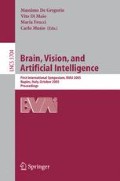Abstract
The human capability of recognizing objects visually is here held to be a function emerging as result of interactions between epigenetic influences and basic neural plasticity mechanisms. The model here proposed simulates the development of the main neural processes of the visual system giving rise to the higher function of recognizing objects. It is a hierarchy of artificial neural maps, mainly based on the LISSOM architecture, achieving self-organization through simulated intercortical lateral connections.
Access this chapter
Tax calculation will be finalised at checkout
Purchases are for personal use only
Preview
Unable to display preview. Download preview PDF.
References
Bednar, J.A.: Learning to See: Genetic and Environmental Influences on Visual Development. PhD thesis, University of Texas at Austin, Tech. Report AI-TR-02-294 (2002)
Burkhalter, A., Bernardo, K.L., Charles, V.: Development of local circuits in human visual cortex. Journal of Neuroscience 13, 1916–1931 (1993)
Chapman, B., Stryker, M.P., Bonhoeffer, T.: Development of orientation preference maps in ferret primary visual cortex. Journal of Neuroscience 16, 6443–6453 (1996)
Dannemiller, J.L.: A test of color constancy in 9- and 20-weeks-old human infants following simulated illuminant changes. Developmental Psychology 25, 171–184 (1989)
Dowling, J.E.: The Retina: An Approachable Part of the Brain. Cambridge University Press, Cambridge (1987)
Essen, D.C.V., Lewis, J.W., Drury, H.A., Hadjikhani, N., Tootell, R.B., Bakircioglu, M., Miller, M.I.: Mapping visual cortex in monkeys and humans using surface-based atlases. Vision Research 41, 1359–1378 (2001)
Farah, M.J., Aguirre, G.K.: Imaging visual recognition: Pet and fmri studies of the functional anatomy of human visual recognition. Trends in Cognitive Sciences 3, 179–186 (1999)
Gerhardstein, P., Kovacs, I., Ditre, J., Feher, A.: Detection of contour continuity and closure in three-month-olds. Vision Research 44, 2981–2988 (2004)
Gödecke, I., Bonhoeffer, T.: Development of identical orientation maps for two eyes without common visual experience. Nature 379, 251–254 (1996)
Grill-Spector, K., Kourtzi, Z., Kanwisher, N.: The lateral occipital complex and its role in object recognition. Vision Research 41, 1409–1422 (2001)
Hou, C., Pettet, M.W., Sampath, V., Candy, T.R., Norcia, A.M.: Development of the spatial organization and dynamics of lateral interactions in the human visual system. Journal of Neuroscience 23, 8630–8640 (2003)
Katz, L.C., Callaway, E.M.: Development of local circuits in mammalian visual cortex. Science 255, 209–212 (1992)
Kirkwood, A., Bear, M.F.: Hebbian synapses in visual cortex. Journal of Neuroscience 14, 1634–1645 (1994)
Kohonen, T.: Self-Organizing Maps. Springer, Berlin (1995)
Landisman, C.E., Ts’o, D.Y.: Color processing in macaque striate cortex: Relationships to ocular dominance, cytochrome oxidase, and orientation. Journal of Neurophysiology 87, 3126–3137 (2002)
Leushina, L.I., Nevskaya, A.A.: Development of vision and visual notions in infants. Journal of Evolutionary Biochemistry and Physiology 39, 67–76 (2003); Translated from Zhurnal Evolyutsionnoi Biokhimii i Fiziologii
Malach, R., Reppas, J.B., Benson, R.R., Kwong, K.K., Jiang, H., Kennedy, W.A., Ledden, P.J., Brady, T.J., Rosen, B.R., Tootell, R.B.: Object-related activity revealed by functional magnetic resonance imaging in human occipital cortex. Proceedings of the Natural Academy of Science USA 92, 8135–8139 (1995)
Miller, K.D., Keller, J.B., Stryker, M.P.: Ocular dominance column development: Analysis and simulation. Science 245, 605–615 (1989)
Murase, H., Nayar, S.: Visual learning and recognition of 3-d object by appearence. International Journal of Computer Vision 14, 5–24 (1995)
Quartz, S.R., Sejnowski, T.J.: The neural basis of cognitive development: a constructivist manifesto. Behavioral and Brain Science 20, 537–596 (1977)
Sengpiel, F., Kind, P.C.: The role of activity in development of the visual system. Current Biology 12, 818–826 (2002)
Sirosh, J., Miikkulainen, R.: Topographic receptive fields and patterned lateral interaction in a self-organizing model of the primary visual cortex. Neural Computation 9, 577–594 (1997)
Smith, L.B.: Children’s noun learning: How general learning processes make specialized learning mechanisms. In: MacWhinney, B. (ed.) The Emergence of Language, 2nd edn. Lawrence Erlbaum Associates, Mahwah (1999)
Tootell, B.H., Silverman, M.S., Hamilton, S.L., Switkes, E., De Valois, R.: Functional anatomy of the macaque striate cortex. V. spatial frequency. Journal of Neuroscience 8, 1610–1624 (1988)
Tootell, B.H., Switkes, E., Silverman, M.S., Hamilton, S.L.: Functional anatomy of the macaque striate cortex. II. retinotopic organization. Journal of Neuroscience 8, 1531–1568 (1988)
Vanduffel, W., Tootell, R.B.H., Schoups, A.A., Orban, G.A.: The organization of orientation selectivity throughout the macaque visual cortex. Cerebral Cortex 12, 647–662 (2002)
von der Malsburg, C.: Self-organization of orientation sensitive cells in the striate cortex. Kibernetic 14, 85–100 (1973)
von Glasersfel, E.: The construction of Knowledge: Contributions to Conceptual Semantics. Intersystems Publications, Seaside (1987)
von Uexküll, J.: Umwelt und Innenwelt der Tiere. Springer, Berlin (1921)
Zeki, S.: Colour coding in the cerebral cortex: The reaction of cells in monkey visual cortex to wavelenghts and colours. Neuroscience 9, 741–765 (1983)
Author information
Authors and Affiliations
Editor information
Editors and Affiliations
Rights and permissions
Copyright information
© 2005 Springer-Verlag Berlin Heidelberg
About this paper
Cite this paper
Domenella, R.G., Plebe, A. (2005). A Neural Model of Human Object Recognition Development. In: De Gregorio, M., Di Maio, V., Frucci, M., Musio, C. (eds) Brain, Vision, and Artificial Intelligence. BVAI 2005. Lecture Notes in Computer Science, vol 3704. Springer, Berlin, Heidelberg. https://doi.org/10.1007/11565123_12
Download citation
DOI: https://doi.org/10.1007/11565123_12
Publisher Name: Springer, Berlin, Heidelberg
Print ISBN: 978-3-540-29282-1
Online ISBN: 978-3-540-32029-6
eBook Packages: Computer ScienceComputer Science (R0)

